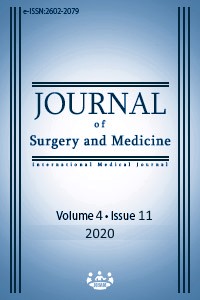Comparison of non-severe COVID-19 pneumonia patients treated with lopinavir/ritonavir and favipiravir
Keywords:
COVID 19, non severe pneumonia, lopinavir ritonavir, favipiravirAbstract
Aim: There is no proven medical treatment for COVID-19 to date. We aimed to evaluate the effectiveness of LPV/r and FVR treatments in non-severe COVID-19 pneumonia patients and compare the clinical outcomes. Methods: In this retrospective cohort study, the data of non-severe COVID-19 pneumonia patients treated with lopinavir/ritonavir and FVR were analyzed. Results: A total of 91 non-severe COVID-19 patients, 33 (36.2%) treated with LPV/r and 58 (63.8%) treated with FVR, were included in the study. The mean ages of the LPV/r group and FVR group were 53.1 (13) years and 57.2 (17.44) years, respectively (P=0.24). There was no statistically significant difference between the two groups in terms of comorbidities (P=0.06). FVR patients had higher radiological weight scores than LPV/r patients, but this was not statistically significant (8.67 (3.7) vs 7.66 (3.22) P=0.2, respectively). While SpO2 levels of FVR patients at the time of admission were lower than those of LPV/r patients, CRP levels were higher (92.22 (2.8) vs 97.87 (2.05), P<0.001, respectively and 75.42 (62) vs 45.42 (49.92), P=0.02, respectively). FVR patients had a shorter fever regression time than LPV/r patients (2.7 (0.9) vs 4 (1), P<0.001, respectively). Post-treatment neutrophil, lymphocyte, N/L ratio and D-Dimer levels decreased more in FVR group compared to the LPV/r group (P=0.01, <0.001, 0.001, <0.001, respectively). Conclusion: Although non-severe COVID-19 patients using FVR had lower oxygen saturations, more widespread radiological involvement, and higher CRP levels at admission, we found that FVR was more effective in improving laboratory parameters and controlling fever than LPV/r treatment. The efficacy of lopinavir/ritonavir and FVR warrants further verification by future, larger studies.
Downloads
References
World Health Organization (WHO): Coronavirus Disease (COVID-2019) Situation Reports, 2020. https://www.who.int/emergencies/diseases/novel-coronavirus-2019/situation-reports. Accessed 30 June 2020.
Ayten O, Ozdemir C, Akturk UA, Sen N, Potential Treatment of COVID-19. Coronavirus Disease 2019 (COVİD 19) and Lung. Euroasian Journal of Pulmonology. 2020;22(4):35-44.
Morse JS, Lalonde T, Xu S, Liu WR. Learning from the past: possible urgent prevention and treatment options for severe acute respiratory infections caused by 2019-nCoV. Chembiochem. 2020;21(5):730-8.
Chan KS, Lai ST, Chu CM, Tsui E, Tam CY, Wong MM, et al. Treatment of severe acute respiratory syndrome with lopinavir/ritonavir: a multicentre retrospective matched cohort study. Hong Kong Med J. 2003;9(6):399–406.
Chu CM, Cheng VC, Hung IF, Wong MM, Chan KH, Chan KS, et al. Role of lopinavir/ritonavir in the treatment of SARS: Initial virological and clinical findings. Thorax. 2004;59(3):252‐6.
De Clercq E. New nucleoside analogues for the treatment of hemorrhagic fever virus infections. Chem. Asian J. 2019;14:3962–8.
Cao B, Wang Y, Wen D, Liu W, Wang J, Fan G, et al. A Trial of Lopinavir–Ritonavir in Adults Hospitalized with Severe Covid-19. N Engl J Med. 2020;382:1787-99.
Cai Q, Yang M, Liu D, Chen J, Shu D, Xia J, et al. Experimental treatment with favipiravir for COVID-19: An open-label control study. Engineering 2020 March 18. [E-pub ahead of print] doi: 10.1016/j.eng.2020.03.007
Chen C, Zhang Y, Huang J, Yin P, Cheng Z, Wu J, et al. Favipiravir versus arbidol for COVID-19: A trial. BioRxiv 2020 April 15. [E-pub ahead of print] doi: 10.1101/2020.03.17. 20037432
Chang Y, Yu C, Chang S, Galvin JR, Liu H, Hsiao C, et al. Pulmonary sequelae in convalescent patients after severe acute respiratory syndrome: evaluation with thin-section CT. Radiology. 2005;236(3):1067–75.
Norman, G. Likert scales, levels of measurement and the laws of statistics. Advances in Health Sciences Education. 2010;15(5):625-32.
Huang C, Wang Y, Li X, Ren L, Zhao J, Hu Y, et al. Clinical features of patients infected with 2019 novel coronavirus in Wuhan, China. Lancet. 2020;395:497–506.
Wang D, Hu B, Hu C, Zhu F, Liu X, Zhang J, et al. Clinical characteristics of 138 hospitalized patients with 2019 novel coronavirus-infected pneumonia in Wuhan, China. JAMA. 2020;323(11):1061-9.
Giovanni PG, Maccaferrib M, Ruinia C, Tomasia A, Ozbend T. Biomarkers associated with COVID-19 disease progression. Critical Reviews in Clinical Laboratory Sciences. 2020;57(6):389-99.
Bao J, Li C, Zhang K, Kang H, Chen W, Gu B, Comparative analysis of laboratory indexes of severe and non-severe patients infected with COVID-19. Clinica Chimica Acta. 2020;509:180-94.
National Health Commission & State Administration of Traditional Chinese Medicine: Guidelines for the Prevention, Diagnosis, and Treatment of Novel Coronavirus-induced Pneumonia, The 7th edition, 2020 March 3. http://www.nhc.gov.cn/yzygj/s7653p/202002/ 8334a832 6d. Accessed 30 June 2020
Downloads
- 455 924
Published
Issue
Section
How to Cite
License
Copyright (c) 2020 Omer Ayten, Bengü Şaylan
This work is licensed under a Creative Commons Attribution-NonCommercial-NoDerivatives 4.0 International License.
















